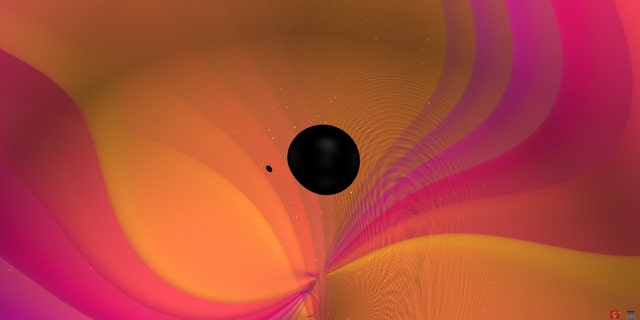Astronomers have spotted a mystery object that they say could be a black hole or a neutron star.
Both black holes and neutron stars are the remains of dead stars.
“When the most massive stars die, they collapse under their own gravity and leave behind black holes; when stars that are a bit less massive die, they explode in a supernova and leave behind dense, dead remnants of stars called neutron stars,” explains the Laser-Interferometer Gravitational-Wave Observatory (LIGO) in a statement.
BLACK HOLE DEVOURING A NEUTRON STAR CAUSED RIPPLES IN SPACE AND TIME, SCIENTISTS SAY
LIGO, which is operated by MIT and Caltech, supported by the National Science Foundation, explained that astronomers have long been fascinated by the “gap” that lies between black holes and neutron stars. “The heaviest known neutron star is no more than 2.5 times the mass of our sun, or 2.5 solar masses, and the lightest known black hole is about 5 solar masses,” it explained in a statement. “The question remained: does anything lie in this so-called mass gap?”

Visualization of GW190814. (Credit: N. Fischer, S. Ossokine, H. Pfeiffer, A. Buonanno [Max Planck Institute for Gravitational Physics], Simulating eXtreme Spacetimes [SXS] Collaboration.)
In a new study undertaken by LIGO and the Virgo detector in Europe, scientists announced the discovery of an object of 2.6 solar masses, putting it firmly in the mass gap. “The object was found on August 14, 2019, as it merged with a black hole of 23 solar masses, generating a splash of gravitational waves detected back on Earth by LIGO and Virgo,” scientists said in the statement.
A paper on the discovery has been accepted for publication in The Astrophysical Journal Letters.
MYSTERIOUS REPEATING RADIO SIGNALS FROM OUTSIDE OUR GALAXY DISCOVERED
Astronomers from Northwestern University, the University of Wisconsin, Milwaukee and Italy’s University of Padova also participated in the research.
![Artist's rendition of a mystery object in 'Mass Gap' found by LIGO and Virgo. (Image credit: LIGO/Caltech/MIT/R. Hurt [IPAC])](https://a57.foxnews.com/static.foxnews.com/foxnews.com/content/uploads/2020/06/640/320/LIGOObject2.jpg?ve=1&tl=1)
Artist's rendition of a mystery object in 'Mass Gap' found by LIGO and Virgo. (Image credit: LIGO/Caltech/MIT/R. Hurt [IPAC])
"We've been waiting decades to solve this mystery," said study co-author Vicky Kalogera, a professor at Northwestern University, in the statement. "We don't know if this object is the heaviest known neutron star, or the lightest known black hole, but either way it breaks a record.”
"This is going to change how scientists talk about neutron stars and black holes," added co-author Patrick Brady, a professor at the University of Wisconsin, Milwaukee, and the LIGO Scientific Collaboration spokesperson, in the statement. "The mass gap may, in fact, not exist at all but may have been due to limitations in observational capabilities. Time and more observations will tell."
SCIENTISTS EXPLAIN 'STRANGE ASYMMETRY' MYSTERY FOR THE FAR SIDE OF MOON IN NEW RESEARCH
The cosmic merger was dubbed GW190814 and resulted in a final black hole about 25 times the mass of the sun, located about 800 million light-years from Earth. Scientists note that some of the merged mass was converted to a blast of energy in the form of gravitational waves.
“Before the two objects merged, their masses differed by a factor of 9, making this the most extreme mass ratio known for a gravitational-wave event,” said scientists, in the statement.
A light-year, which measures distance in space, equals about 6 trillion miles.
STUNNING PICTURES SHOW PARTIAL 'RING OF FIRE' SOLAR ECLIPSE
Last year, in a separate study, scientists, for the first time, detected a black hole devouring a neutron star.
CLICK HERE TO GET THE FOX NEWS APP
The Australian National University (ANU), which participated in the research, explained that the “cataclysmic event” was detected on Aug. 14, 2019, by gravitational-wave discovery machines in the U.S. and Italy. The machines detected ripples in space and time from an event that happened about 8,550 million trillion kilometers away from Earth, ANU said in a statement.
Follow James Rogers on Twitter @jamesjrogers
https://news.google.com/__i/rss/rd/articles/CBMiR2h0dHBzOi8vd3d3LmZveG5ld3MuY29tL3NjaWVuY2UvYXN0cm9ub21lcnMtc3BvdC1kaXN0YW50LW15c3Rlcnktb2JqZWN00gFLaHR0cHM6Ly93d3cuZm94bmV3cy5jb20vc2NpZW5jZS9hc3Ryb25vbWVycy1zcG90LWRpc3RhbnQtbXlzdGVyeS1vYmplY3QuYW1w?oc=5
2020-06-24 15:27:05Z
52780873763761
Tidak ada komentar:
Posting Komentar